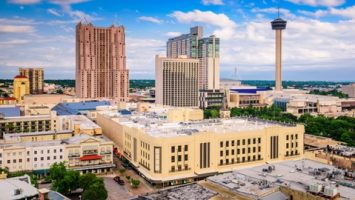
Smart Cities Connect Conference and Expo hits the road next April to Denver, Colorado where we will host our fourth annual summit. Denver and the surrounding area is truly outstanding not only in its ability to collaborate and innovate but also for the meaningful projects it has unveiled in recent years. To share a bit more about that, I interviewed Emily Silverman, Smart Cities Program Manager for the City and County of Denver. Check out what she has to say here:
LB: You are the program manager for smart cities in Denver. Tell me a bit about what it means to be in that role within the city and county.
ES: The City and County of Denver is a great place to work, live, and play. This is evident by the city’s population growth of 15,000 residents annually. While this exponential growth is good for economic development, it also means Denver faces increasing challenges like traffic congestion, air quality issues, and affordable housing shortages. We acknowledged these complex 21st century problems needed a 21st century solution though the use of technology and innovation – this became Denver Smart City.
My job, as the Program Manager for Denver Smart City, is to align the projects and initiatives that utilize 21st century technology to deliver city services that improve both the safety and the experience for everyone in our city. Day-to-day, I am constructing cross functional teams to convert data from many disparate smart city systems into actionable intelligence that will improve outcomes. My goal is to support my team, while bringing data and initiatives together, ensuring our residents, visitors and businesses are connected to city services through the pairing of technology.
LB: As the driver for smart cities initiatives, what is your vision for Denver as a smart community? What goals drive you day-to-day?
ES: Denver Smart City uses data to make our city better. To me, Denver Smart City will use technology and data to ensure residents receive immediate, complete access to city services in a manner that is mobile, affordable, and environmentally sustainable. Building on existing efforts and partnerships, we seek to improve the quality of life for Denver residents through the technology and data.
I believe that Denver Smart City will see the convergence of technology and innovation, creating an opportunity to use the city as a platform to help solve Denver’s biggest pain points and improve the quality of life for anyone that lives, work, or plays in Denver. Each day, I am inspired by the people I have met in the seven years that I’ve worked at the city. From a man who, despite his sight impairments, walks his eight-year-old child to school morning to the our women and men behind the badge who put their life on the line each day, it is our responsibility to use data to make their lives better.
LB: You bring together many stakeholders in the area and get everyone on the same page. When has that been the most challenging, and when has it been the most rewarding?
ES: In the formative stages of the City and County of Denver Smart City Program, it was challenging to get everyone to understand both the strategic benefits and the benefits of sharing information across organizations. However, after conducting a series of workshops and educational sessions, we discovered there was interest in technology platforms and the “things” of IoT, including the promise of what could be delivered. It is great to brainstorm solutions for Denver to improve the lives of our residents; however, it is paramount to ensure the solutions draw a realistic link between the products and the community need. By directly reaching out to the community through PhotoVoice, we have been able to connect with our under-served residents, giving them a chance to share what they love about their community and what they struggle with on a day-to-day basis. PhotoVoice is a photography workshop focused on empowering local residents to tell their story visually and share it with city leaders.
I am continually amazed by the incredible talent and breadth of knowledge of the people working for the city. I am inspired by the cross-functional team brainstorming and complex problem solving happening from a holistic viewpoint, entirely with a citizen-centric perspective. Witnessing this team work together with their clear focus on residents helps keep me energized and excited to continue to support both the team members and key stakeholders within and outside of the City and County of Denver.
LB: Denver has a number of well-known partnerships, resulting in Living Labs. Can you tell me a bit more about that?
ES: Denver Smart City has had the unique opportunity to install, understand and evaluate smart technologies in what we call “living labs.” One such living lab focuses on understanding the connecting vehicle and detection technology at 29th Avenue and Federal Boulevard. We have harnessed and relayed data from the area, employing the data discovered from this integration in ways that will ultimately improve transportation, reduce congestion and get people to their destinations quickly and safely. The primary goal, and first step of this $1M effort, is to establish links between vehicles on the road (utilizing their existing on-board equipment) and roadside infrastructure (traffic signals) that will feed information into a city enterprise data management system and our traffic management center, thereby allowing us to develop policies and programs that help protect individuals.
The other living lab, at Peña Station NEXT, is the result of a public-private partnership between the City and County of Denver, Panasonic and other stakeholders. Peña Station NEXT is a one-of-a-kind technology test-site for renewable energy, next-generation connected vehicles, electric vehicle charging and smart lighting. Smart lighting gives us control of the streetlights, with the goal of maximizing safety while minimizing light pollution while using less energy with LED lighting. Additionally, we all know that the real value of autonomous vehicles lies in shared mobility and energy efficiency. Our partnership with Panasonic and Easymile focuses on all three value propositions of autonomy, shared mobility and electrification, which is good for Denver and the region.
LB: When conference-goers visit Denver, what can they expect to find and how will they see smart solutions at work in real life?
ES: Through the Denver Smart City Program, we are currently developing several efforts that we hope to implement very soon. I will highlight a few of them below. Our hope, when applied, would be that conference-goers would be able to learn and see these innovations in action.
1. Connect vehicle and detection technology
As part of the living lab in central Denver, we are working to establish links between the existing vehicle and detection technology through four case studies at Federal Boulevard and 29th Avenue: connected pedestrians, connected bikes, connected transit and emergency vehicle preemption. Specifics of two of the use cases are below:
Connected pedestrians: This first case study is to establish a pedestrian detection system that communicates to the traffic signal, resulting in a more dynamic, real time transportation system that could extend a walk signal if someone needs more time crossing the street. Also, the pedestrian detection system would tell a connected vehicle driver – through their existing on-board equipment – of the pedestrian’s presence in the roadway, thereby preventing a crash and increasing safety. The intersection of Federal Boulevard and 29th Avenue is a great candidate for this, as there is a high school nearby, and we see many students walking in the area.
Emergency vehicle priority: There are several fire stations in the area, and currently, emergency vehicles send a signal to the traffic light that engages a modification in the light’s programing. However, the emergency vehicle does not have confirmation that the change has been received. With this case study, two-way communication between the signal and the emergency vehicle would improve safety and response timing.
2. Air quality sensors
We recently won a Bloomberg Mayors Challenge grant to do real-time air quality monitoring at ten of our public schools. We know that children are particularly susceptible to acute and long-term health effects of air pollution. In fact, Denver families currently spend an average of $3,100 a year on asthma-related medical costs, resulting in more than $30 million spent annually. For this effort, we’re partnering with a local startup on the sensors. This data will be made available so that we can empower communities, families, and schools to protect children’s respiratory health. We will also use the data to inform the development of school-based culturally relevant programs.
Stay tuned in the coming months for more information about the City and County of Denver as we dive deeper to explore their projects, partners, and the region at work to become smarter.


